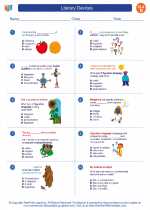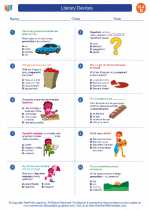Literary Devices Study Guide
What are Literary Devices?
Literary devices are techniques and structures writers use to convey their message and create an impact on the reader. These devices can be found in all types of writing, including poetry, prose, and drama. They are used to add depth and meaning to the text, making it more engaging and memorable for the reader.
Common Literary Devices
- Simile: A comparison using "like" or "as" to describe something, e.g. "Brave as a lion."
- Metaphor: A direct comparison between two unlike things, e.g. "Time is a thief."
- Personification: Giving human qualities to non-human things, e.g. "The wind whispered through the trees."
- Alliteration: The repetition of initial consonant sounds, e.g. "Peter Piper picked a peck of pickled peppers."
- Hyperbole: Exaggerated statements or claims not meant to be taken literally, e.g. "I've told you a million times."
- Onomatopoeia: Words that imitate natural sounds, e.g. "buzz," "hiss," "moo."
- Irony: A contrast between what is expected and what actually happens, e.g. a fire station burning down.
- Symbolism: The use of symbols to represent ideas or qualities, e.g. a dove as a symbol of peace.
- Foreshadowing: A hint of what is to come later in the story, e.g. a character's ominous dream.
- Imagery: Descriptive language that appeals to the senses, e.g. "The aroma of fresh-baked cookies filled the air."
Why are Literary Devices Important?
Literary devices enhance the reading experience by adding depth, emotion, and creativity to the text. They help writers convey their messages in a more impactful and memorable way, allowing readers to connect with the story on a deeper level. Understanding and identifying literary devices can also help readers analyze and appreciate the craft of writing.
Study Tips
Here are some tips for studying literary devices:
- Read widely: Explore different genres and authors to see how literary devices are used in various contexts.
- Take notes: Keep a list of literary devices and examples you come across in your reading.
- Discuss with others: Engage in discussions with classmates or teachers to deepen your understanding of literary devices.
- Practice analysis: Analyze passages from texts to identify and explain the use of literary devices.
- Write creatively: Experiment with using literary devices in your own writing to understand how they work.
[Literary Devices] Related Worksheets and Study Guides:
.◂English Language Arts Worksheets and Study Guides Fourth Grade. Literary Devices
Worksheet/Answer key Literary Devices
Literary Devices  Worksheet/Answer key
Worksheet/Answer key Literary Devices
Literary Devices  Worksheet/Answer key
Worksheet/Answer key Literary Devices
Literary Devices 

 Worksheet/Answer key
Worksheet/Answer key
 Worksheet/Answer key
Worksheet/Answer key

The resources above cover the following skills:
Students apply knowledge of language structure, language conventions (e.g., spelling and punctuation), media techniques, figurative language, and genre to create, critique, and discuss print and nonprint texts. (NCTE)